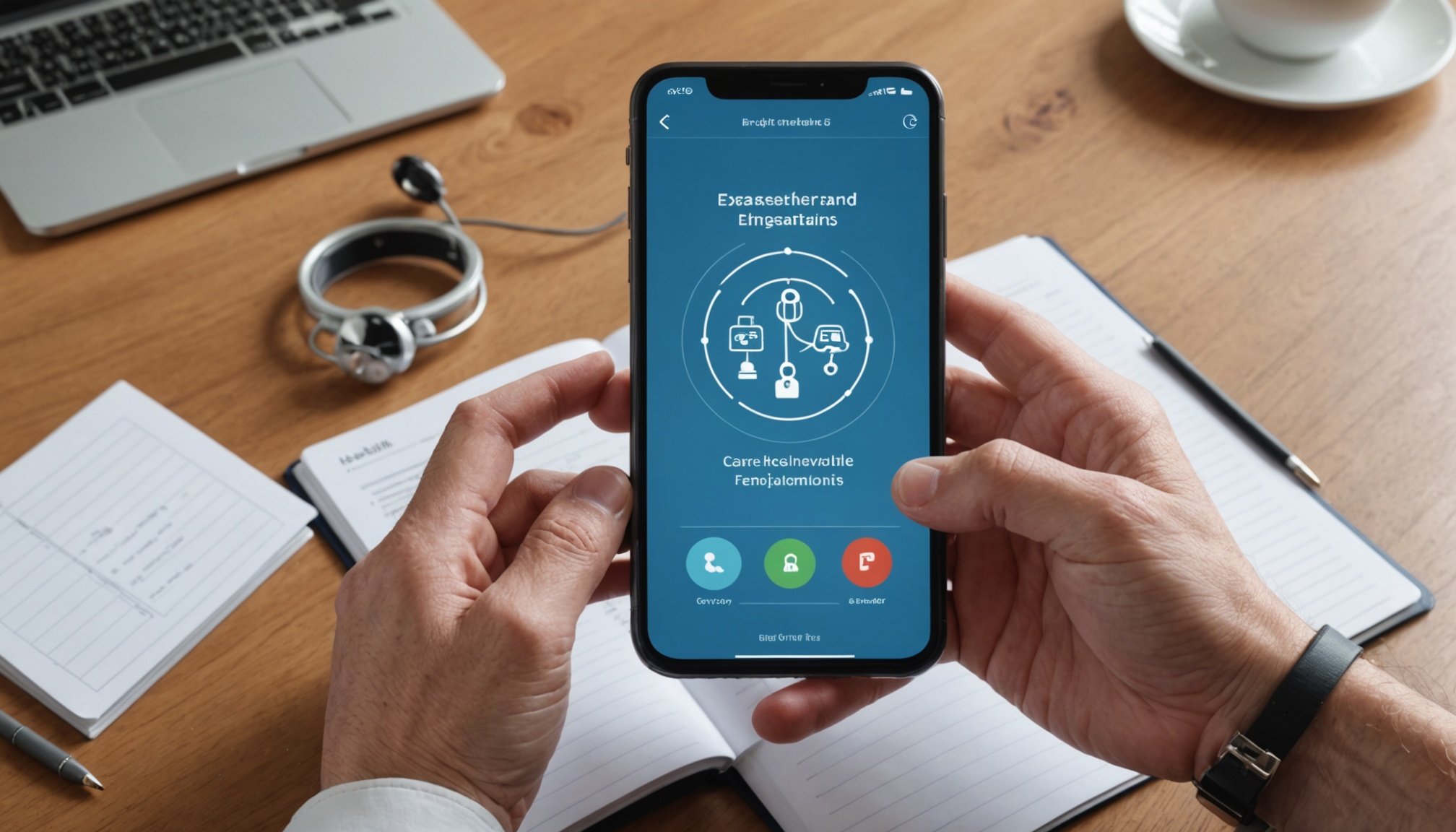Overview of UK Telehealth Regulations
Understanding the UK telehealth regulations is essential for any entity involved in digital healthcare initiatives. This regulatory landscape is shaped by several key legislations that impact how telehealth services, including mobile app practices, operate in the UK.
The primary legislation governing telehealth activities includes the Health and Social Care Act along with the Data Protection Act. These laws establish a robust legal framework that guides the operations of both healthcare providers and telehealth app developers. Compliance is not just a statutory obligation but also reinforces trust in the healthcare services provided online.
Have you seen this : UK Enterprises: Essential Legal Guidance for Navigating Redundancy Challenges
For healthcare providers and app developers, adhering to this legal framework is crucial to avoid legal ramifications and to ensure the safeguarding of patient data. Compliance encompasses various aspects such as data privacy, security, and patient safety. It demands ongoing vigilance and adaptation to any legislative updates that may arise.
In this evolving environment, maintaining compliance is not merely about meeting current standards. It’s about continuously integrating these regulations into daily practices. The importance of doing so cannot be overstated, as it forms the foundation for legal immunity and ethical medical practice in digital health services. Without robust compliance measures, the risk of non-compliance can lead to significant consequences, both legally and reputationally.
Also read : Unlocking Innovation: Crucial Legal Steps for UK Businesses to Safeguard Their Intellectual Property
GDPR and Its Impact on Telehealth Data
The General Data Protection Regulation (GDPR) significantly influences the handling of telehealth data, emphasizing data protection and patient privacy. Under GDPR, organisations offering telehealth services must adhere to strict principles to ensure personal data is processed lawfully and transparently.
Patient consent plays a critical role under GDPR. Before any data collection begins, patients must be informed about what data will be collected, how it will be used, and who it will be shared with. This consent must be explicit and withdrawable, empowering patients with control over their personal information. Organisations must store consent details as evidence of compliance.
Moreover, GDPR endows individuals with data subject rights. Key among them are the right to access data, rectify inaccuracies, and erasure. These rights present considerable implications for telehealth, as patients can request modifications or deletions of their data, compelling providers to have robust systems for data retrieval and modification.
Successfully navigating GDPR mandates involves integrating comprehensive privacy policies and security measures in telehealth platforms, ensuring data encryption and regular audits for compliance. By prioritising these elements, telehealth services not only fulfil legal obligations but also strengthen patient trust by upholding their privacy.
Data Security Measures for Mobile Apps
In today’s digital landscape, robust data security measures are fundamental to ensuring the integrity of telehealth services. Mobile app developers must prioritize a multi-layered risk management approach to mitigate potential threats. Key security protocols include the use of encryption and data anonymization, which serve as critical compliance elements. By encrypting data, developers can prevent unauthorized access, ensuring that sensitive information remains confidential.
Data anonymization plays a pivotal role by removing identifiable information, thereby reducing the risk of breaches. Implementing these strategies effectively requires an understanding of both technical and regulatory requirements critical to telehealth services. Encryption ensures data is unreadable to unauthorized parties, offering a dynamic defense mechanism against cyber threats.
App developers should adopt best practices to enhance mobile app security, such as regular security audits, implementing secure coding techniques, and timely software updates. Additionally, conducting comprehensive penetration tests can identify potential vulnerabilities before they become critical issues. It’s imperative for developers to remain proactive, continuously evaluating and updating security protocols to align with evolving threats and regulatory standards, ensuring both compliance and patient trust in digital healthcare solutions.
Legal Implications of Data Breaches
The occurrence of data breaches in telehealth can lead to significant legal consequences and financial liabilities for healthcare providers and app developers. When a breach occurs, it is not merely a technical fault; it represents a breach of legal responsibility. As per UK telehealth regulations, entities must promptly report breaches to relevant regulatory bodies, like the Information Commissioner’s Office (ICO), within 72 hours. Failure to do so may result in severe penalties, including hefty fines and reputational damage.
High-profile cases illustrate the ramifications of non-compliance. For instance, several healthcare providers have faced public scrutiny and legal challenges because of inadequate security measures leading to data leaks. Such precedents underscore the critical need for diligent risk management practices to mitigate threats.
Healthcare entities should maintain comprehensive incident response plans and conduct regular security audits to fortify their defensive measures. Moreover, fostering a culture of transparency and swift action in the face of breaches is essential. By understanding their legal responsibilities, providers can more effectively navigate the complexities of data protection laws and ensure they are prepared to address breaches, thus safeguarding both their patients’ data and their organisational integrity.
Expert Insights on Compliance Challenges
Navigating compliance challenges within UK telehealth regulations demands expertise and precision. Legal and healthcare experts emphasise understanding the stringent regulatory environment as a critical factor. Key insights reveal that many providers grapple with aligning with these regulations, often underestimating the robust legal framework required.
Common compliance pitfalls occur during app development, from data mismanagement to insufficient security measures. Developers often face hurdles in interpreting regulatory texts accurately, leading to partial compliance, which can have significant repercussions. Therefore, adopting a meticulous approach from the outset is essential.
Experts recommend proactive measures to mitigate these challenges. Ongoing legal education ensures that healthcare entities keep pace with evolving regulations. This involves regular training sessions and updates on legislative changes, fostering a culture of continuous learning. Notably, seeking legal advice during the development and implementation phases of telehealth apps can provide clarity and enhance compliance.
Building a knowledge base within organisations, leveraging industry practices, and engaging with regulatory bodies also contribute to overcoming compliance hurdles. Combining insights from legal and healthcare professionals equips providers with strategic advantages, ultimately safeguarding patient data and ensuring adherence to the legal aspects of telehealth services.
Actionable Guidelines for Developers and Providers
In the realm of telehealth applications, ensuring compliance is not only essential but also complex. To help developers and providers navigate this landscape effectively, a structured approach is essential. Here, we outline key actionable guidelines.
Compliance Checklist
- Understand the core regulations like the GDPR and Health and Social Care Act. Regularly review these for updates.
- Adopt a comprehensive risk management strategy, utilising robust encryption and anonymization techniques to protect patient data.
- Develop a clear patient consent framework to ensure compliance with data protection laws. Make sure consent is explicit, documented, and withdrawable.
Staying Updated
It’s crucial to be informed about ongoing regulatory changes. Subscribe to industry newsletters, attend relevant seminars, and participate in webinars focused on telehealth legislation.
Collaboration Strategies
Fostering collaboration between developers and healthcare organisations will enhance compliance efforts. Regular cross-functional meetings to discuss compliance objectives and challenges will enable better integration of regulations into daily practices.
Best practices include establishing a compliance officer role within the organisation to oversee and continuously improve adherence strategies. By following these guidelines, both developers and providers can effectively align with the sophisticated regulations governing telehealth, ensuring patient safety and organisational integrity.
Future Trends in Telehealth Regulation
The future of telehealth regulation in the UK anticipates notable advancements and industry innovations. As technology evolves, so too must the regulatory landscape, creating new opportunities and challenges for those in digital healthcare.
Anticipated Regulatory Changes
Emerging telehealth trends suggest future regulations will address advances in AI and machine learning. These technologies promise to augment diagnostics and patient care but require a tailored legal framework to ensure data security and patient safety. Anticipating changes means staying informed and preparing for a dynamic regulatory environment.
Impacts of Technological Advancements
Technological progress will influence regulatory updates, especially in areas like remote monitoring and data interoperability. The introduction of wearable devices and IoT healthcare solutions demands enhanced compliance measures to support seamless integration with existing systems while safeguarding patient data.
Preparing for Future Challenges
Healthcare providers and developers must proactively address upcoming compliance challenges by implementing agile strategies. These include investing in robust cybersecurity solutions and creating flexible compliance frameworks responsive to evolving regulations. Engaging with regulatory bodies and participating in industry forums can provide valuable insights into potential shifts in the regulatory landscape, enabling stakeholders to navigate future changes effectively.











